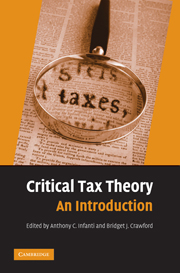Book contents
- Frontmatter
- Contents
- List of Illustrations
- List of Tables
- List of Contributors
- List of Common Abbreviations
- Introduction
- CHAPTER 1 FOUNDATIONS OF CRITICAL TAX THEORY
- CHAPTER 2 HISTORICAL PERSPECTIVES ON TAXATION
- CHAPTER 3 THE GOALS OF TAX POLICY
- CHAPTER 4 CRITICAL TAX THEORY MEETS PRACTICE
- A Legislator Named Sue: Re-Imagining the Income Tax
- Using the Social Background Model to Explain Who Wins Federal Appellate Tax Decisions: Do Less Traditional Judges Favor the Taxpayer?
- Tax Protest, “A Homosexual,” and Frivolity: A Deconstructionist Meditation
- Sisters in Law: Gender and the Interpretation of Tax Statutes
- Deconstructing the Duty to the Tax System: Unfettering Zealous Advocacy on Behalf of Lesbian and Gay Taxpayers
- CHAPTER 5 RACE AND TAXATION
- CHAPTER 6 GENDER AND TAXATION
- CHAPTER 7 SEXUAL ORIENTATION AND TAXATION
- CHAPTER 8 THE FAMILY AND TAXATION
- CHAPTER 9 CLASS AND TAXATION
- CHAPTER 10 DISABILITY AND TAXATION
- CHAPTER 11 GLOBAL CRITICAL PERSPECTIVES ON TAXATION
- CHAPTER 12 CRITICAL PERSPECTIVES ON CRITICAL TAX THEORY
- Index
Sisters in Law: Gender and the Interpretation of Tax Statutes
Published online by Cambridge University Press: 04 August 2010
- Frontmatter
- Contents
- List of Illustrations
- List of Tables
- List of Contributors
- List of Common Abbreviations
- Introduction
- CHAPTER 1 FOUNDATIONS OF CRITICAL TAX THEORY
- CHAPTER 2 HISTORICAL PERSPECTIVES ON TAXATION
- CHAPTER 3 THE GOALS OF TAX POLICY
- CHAPTER 4 CRITICAL TAX THEORY MEETS PRACTICE
- A Legislator Named Sue: Re-Imagining the Income Tax
- Using the Social Background Model to Explain Who Wins Federal Appellate Tax Decisions: Do Less Traditional Judges Favor the Taxpayer?
- Tax Protest, “A Homosexual,” and Frivolity: A Deconstructionist Meditation
- Sisters in Law: Gender and the Interpretation of Tax Statutes
- Deconstructing the Duty to the Tax System: Unfettering Zealous Advocacy on Behalf of Lesbian and Gay Taxpayers
- CHAPTER 5 RACE AND TAXATION
- CHAPTER 6 GENDER AND TAXATION
- CHAPTER 7 SEXUAL ORIENTATION AND TAXATION
- CHAPTER 8 THE FAMILY AND TAXATION
- CHAPTER 9 CLASS AND TAXATION
- CHAPTER 10 DISABILITY AND TAXATION
- CHAPTER 11 GLOBAL CRITICAL PERSPECTIVES ON TAXATION
- CHAPTER 12 CRITICAL PERSPECTIVES ON CRITICAL TAX THEORY
- Index
Summary
There is both obvious and not-so-obvious diversity in the legal profession, even behind the apparent homogeneity of the upper-middle-class mainstream legal elite. The differences play themselves out not only in our substantive conclusions as lawyers but also in the way we reason, not only in our policy judgments but also in our methodology. My particular concern in this essay is how these differences manifest themselves in the central task of tax lawyering: statutory construction.
In Zen and the Art of Statutory Construction pursuant to the view that only politically authorized decision makers legitimately can define the scope of legal rights and duties, I proposed that lawyers approach statutory interpretation as an attempt to adopt the perspective of the historic drafter(s). I was startled by the fervor with which several colleagues disputed that it was even possible, let alone appropriate, for interpreters to set aside their preconceptions and assume another's standpoint. I began to detect that women, who uniformly failed to object to the propriety or feasibility of the methodology, were more comfortable with my proposal than men. Quite technical in portions and interspersed with mathematical equations, Zen does not look much like “women's work.” Nevertheless, I had to consider that somehow I brought my womanhood into my professional undertakings, that my work is that of “a lawyer and a woman,” although I have never before formally addressed “women's issues” or referred to feminist scholars.
In this paper, I begin to crystallize my thoughts on why men and women might approach the reading of tax statutes differently.
- Type
- Chapter
- Information
- Critical Tax TheoryAn Introduction, pp. 95 - 99Publisher: Cambridge University PressPrint publication year: 2009



